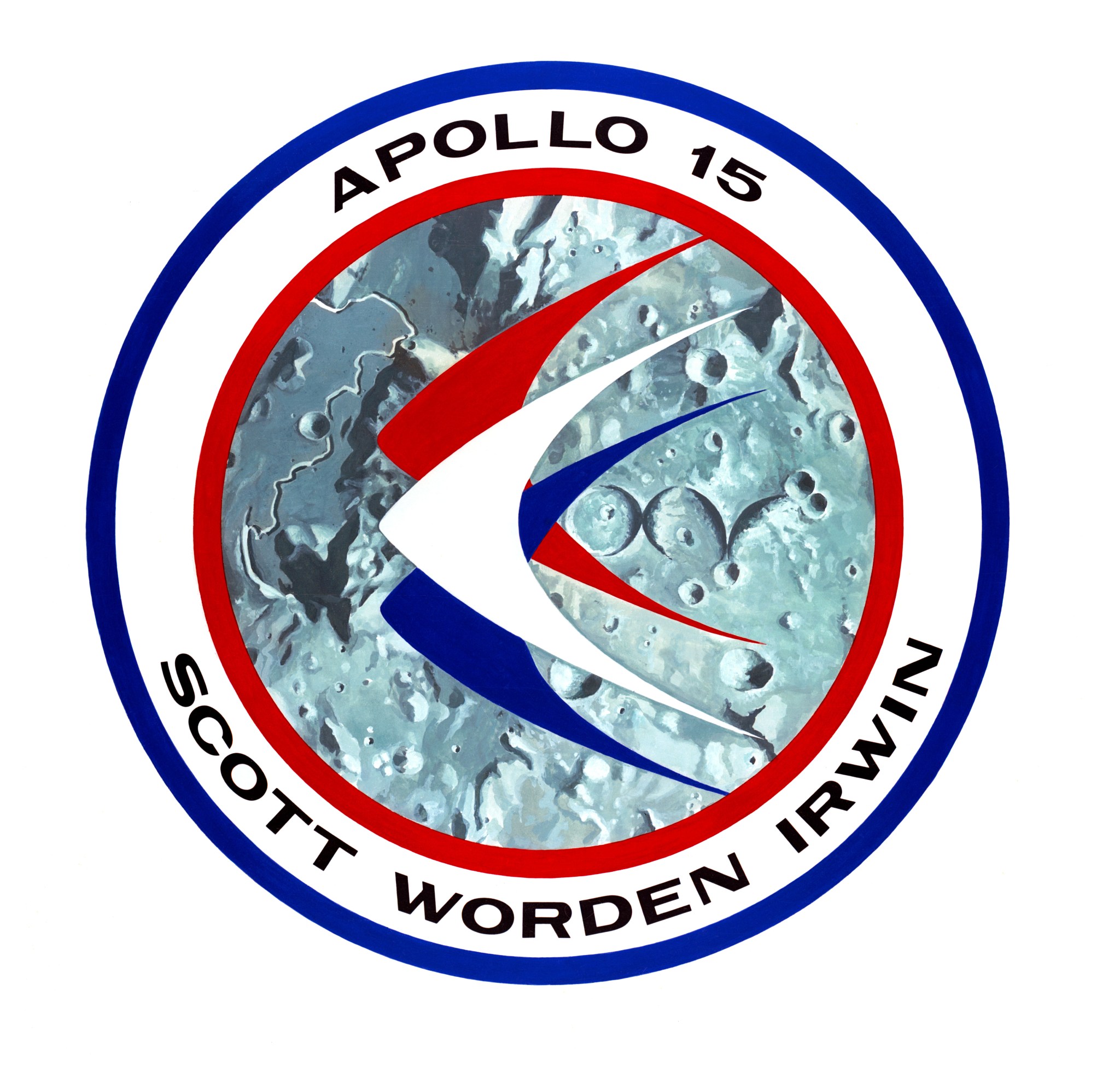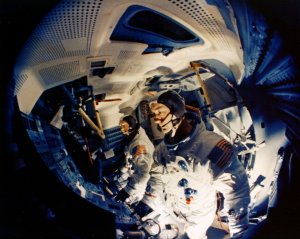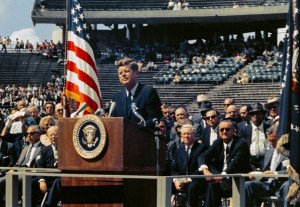"Climb aboard the Lunar Rover…"
Mission Objective
Apollo 15 was the first of the Apollo “J” missions capable of a longer stay time on the moon and greater surface mobility. There were four primary objectives falling in the general categories of lunar surface science, lunar orbital science and engineering-operational. The mission objectives were to explore the Hadley-Apennine region, set up and activate lunar surface scientific experiments, make engineering evaluations of new Apollo equipment, and conduct lunar orbital experiments and photographic tasks.
Exploration and geological investigations at the Hadley-Apennine landing site were enhanced by the addition of the Lunar Roving Vehicle, or LRV. Setup of the Apollo Lunar Surface Experiments Package, or ALSEP, was the third in a trio of operating ALSEPs (on Apollos 12, 14 and 15). Orbital science experiments were concentrated in any array of instruments and cameras in the scientific instrument module, or SIM, bay. Engineering and operational objectives included evaluation of modifications to the lunar module, or LM, made for carrying a heavier payload and for a lunar stay time of almost three days. Changes to the Apollo spacesuit and to the portable life support system, or PLSS, were evaluated, and performance of the Lunar Roving Vehicle and the other new J-mission equipment that went with it—lunar communications relay unit, or LCRU, and the ground-controlled television assembly, or GCTA.
Another major mission objective involved the launching of a Particles and Fields, or P&F, subsatellite into lunar orbit by the command and service module, or CSM, shortly before beginning the return-to-Earth portion of the mission. The subsatellite was designed to investigate the moon’s mass and gravitational variations, particle composition of space near the moon and the interaction of the moon’s magnetic field with that of Earth.

Mission Highlights
Apollo 15 launched from Launch Complex 39 at Cape Canaveral at 9:34 a.m. EDT, only 187 milliseconds off schedule. The translunar injection, or TLI, and hybrid transfer maneuvers were combined into a single “optimized TLI” S-IVB engine burn. A minor problem early in the mission involving a short circuit in a service propulsion engine, or SPS engine, firing switch was successfully cleared through revised procedures for the lunar orbit insertion, or LOI, and subsequent SPS maneuvers.
David Scott and James Irwin flew their LM to a perfect landing at 6:16 p.m. EDT July 30, at Hadley Rille about 1,500 feet north and east of the targeted landing point near a crater named Salyut. Landing approach over the Apennine Range—one of the highest on the moon—was at an angle of 26 degrees, the steepest approach yet used in Apollo missions. During three periods of extravehicular activity, or EVA, on July 31, and Aug. 1 and 2, Scott and Irwin completed a record 18 hours, 37 minutes of exploration, traveled 17.5 miles in the first car that humans have ever driven on the moon, collected more than 170 pounds of lunar samples, set up the ALSEP array, obtained a core sample from about 10 feet beneath the lunar surface, and provided extensive oral descriptions and photographic documentation of geologic features in the vicinity of the landing site during the three days (66 hours, 55 minutes) on the lunar surface.
On Aug. 2, LM Falcon fired its ascent stage engine and lifted off the moon for its rendezvous with command module, or CM, Endeavor. For the first time, the lunar liftoff was seen on Earth via the LRV television camera. The two spacecraft docked as Endeavor began its 50th lunar orbit. On the 74th revolution, the Particles and Fields subsatellite was spring-launched from the service module, or SM, SIM bay. On the next revolution, Aug. 4, a 2-minute, 21-second SPS burn put Apollo 15 on its path back to Earth. On Aug. 5, Alfred Worden became the first human to carry out a deep space EVA. He exited the CM, climbed toward the rear of the SM and retrieved film cassettes from the SIM bay cameras and returned to the CM. The entire operation was completed in 18 minutes (one hour had been scheduled in the flight plan). At approximately 4:46 p.m. EDT Aug. 7, Apollo 15 splashed down in the Pacific Ocean, about 335 miles north of Honolulu, ending a flight of 12 days, seven hours. The crew was picked up by helicopters from the prime recovery ship, the USS Okinawa, 6.32 miles from the targeted touchdown point. During the final stages of descent on its three main parachutes, the CM crew and shipboard observers noted one of the parachutes became only partially inflated following jettison of RSC fuel remaining on board. As a result of the loss of one parachute, the CM impacted at 21.8 mph, instead of the planned 19 mph.
Apollo 15 set several new records for crewed spaceflight: heaviest payload in a lunar orbit of approximately 107,000 pounds, maximum radial distance traveled on the lunar surface away from the spacecraft of about 17.5 miles (previous high was 2.1 miles on Apollo 14), most lunar surface EVAs (three) and longest total of duration for lunar surface EVAs (18 hours, 37 minutes—almost the total time spent in lunar orbit by Apollo 8), longest time in lunar orbit (about 145 hours; only two hours less than the entire Apollo 8 mission), longest crewed lunar mission (295 hours), longest Apollo mission (295 hours—previous high was 244 hours, 36 minutes on Apollo 12), the first satellite placed in lunar orbit by a crewed spacecraft, and first deep space and operational EVA.
Crew
David R. Scott, Commander
James B. Irwin, Lunar Module Pilot
Alfred M. Worden, Command Module Pilot
Backup Crew
Richard F. Gordon Jr., Commander
Harrison H. Schmitt, Lunar Module Pilot
Vance DeVoe Brand, Command Module Pilot
Payload
Endeavor (CM-112)
Falcon (LM-10)
Prelaunch Milestones
5/18/70 – S-II ondock at Kennedy
6/13/70 – S-IVB ondock at Kennedy
6/26/70 – S-IU ondock at Kennedy
7/6/70 – S-IC ondock at Kennedy
Launch
July 26, 1971; 9:34:00 a.m. EDT
Launch Pad 39A
Saturn-V AS-510
High Bay 3
Mobile Launcher Platform-3
Firing Room 1
Orbit
Altitude: 99.7 miles
Inclination: 29.679 degrees
Orbits: 74 revolutions
Duration: 12 days, 17 hours, 12 min
Distance: 1,274,137 miles
Lunar Location: Hadley-Apennine
Lunar Coordinates: 26.08 degrees north, 3.66 degrees east
Landing
Aug. 7, 1971, Pacific Ocean
Recovery Ship: USS Okinawa





























